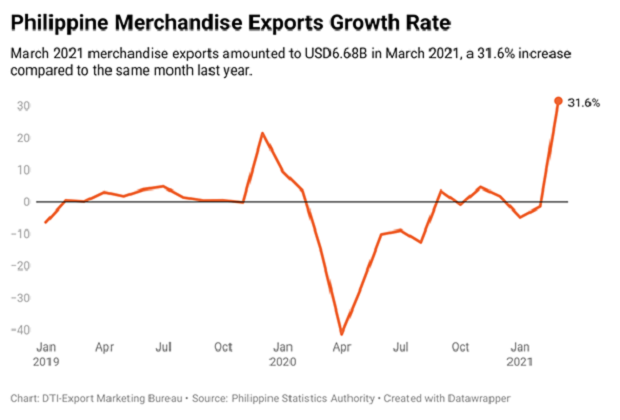The electronics sector helped Philippine merchandise exports in March 2021 rebound strongly and jump by 31.6% compared to the same month last year.

At $6.68 billion, March 2021 exports were even higher than the $6.03 billion earned in March 2019, before the Covid-19 pandemic.
This puts the country’s export growth year-to-date (January to March) in the positive territory at 7.6%, according to preliminary data from the Philippine Statistics Authority (PSA).
Electronics, which make up 61% of all exports, grew by 25% compared to March last year. Department of Trade and Industry (DTI) secretary Ramon Lopez attributed this growth to chip demand due to upgrades to IT systems, new smartphones, auto demand, and automation.
“Factories across the US, Europe, and Asia are ramping up production. And since the Philippines is part of global value chains, our exports recover as more countries reopen,” Lopez said.
He added, “I hope this trend continues so our exporters can hire more people.”
All the top 10 major commodity groups in terms of value exports recorded annual increases led by other mineral products (195.8%), followed by chemicals (159.8%), and other manufactured goods (115.7%).

The ramping up of production in factories across Europe and Asia in March led to a solid recovery in demand. In particular, strong chip demand due to upgrades in IT systems, a new cycle of smartphones, strong auto demand, and moves toward automation increased the exports of electronic parts globally.
Coconut oil was the 10th most exported commodity group and the top agricultural export. Sales of the product increased by 7.8% to $89.05 million.
A 2020 study by the Department of Science and Technology (DOST) found that virgin coconut oil (VCO) can help combat Covid-19 symptoms and prevent mild cases from becoming severe.
Following coconut oil is processed food and beverages which amounted to $81.99 million —a 99.1% growth from March 2020.
China was the top destination for goods, receiving $1.07B or 16% of all Philippine exports. Rounding out the top five trading partners were the US (14.9%), Japan (14.7%), Hong Kong (12.5%), and Singapore (5.2%).




